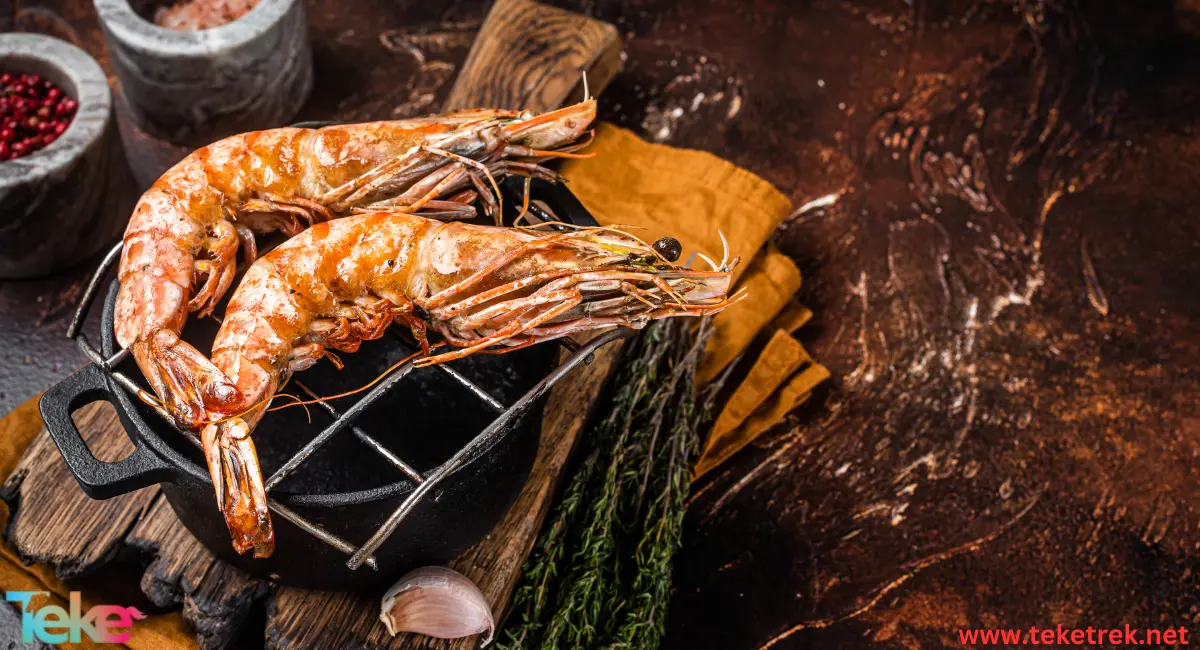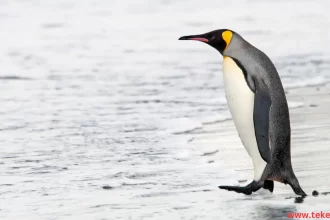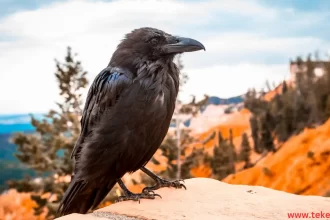Shrimp is a distinctive marine organism, one of 2000 species within the suborder Natantia, a subdivision of the Decapoda order in the class Crustacea, including its relatives such as crabs and lobsters. Shrimp is considered one of the most popular and consumed foods globally, renowned for its delicious taste and high nutritional value. Shrimp fishing and aquaculture are significant industries for many coastal countries
Let’s learn more about it from teketrek.

Specifications and Appearance of Shrimp
Shrimp is characterized by its long, compressed body consisting of a head, carapace, and tail. The shrimp’s carapace is rigid and colorful, ranging in colors from white to pink to red.
Shrimp is distinguished by its large compound eyes, which give it good vision underwater.
Shrimp possesses a number of long, slender legs that it uses for swimming and navigating in the water.
Shrimp has a strong tail that it uses for swimming and movement in the water, typically curved and tapering to a point.
Sizes of shrimp vary among different species. The length of shrimp ranges from a few millimeters to over 20 cm, with an average size of about 4 to 8 cm. The larger species are commonly referred to as prawns.
Shrimp come in various colors including white, pink, red, brown, and blue, with colors differing among species and environmental factors.
Shrimp has small antennae and sharp claws that it uses for defense and for moving on different surfaces.
Shrimp Habitats:
Shrimp can be found in all oceans, both in shallow and deep waters, as well as in freshwater lakes and ponds. There are two species that live near hydrothermal vents near the Mariana Islands.
Smaller species primarily graze on bacterial mats in hydrothermal vent sites, while larger species prey on the smaller ones.
Shrimp Locomotion:
Shrimp do not have fins, but they are highly skilled swimmers. By flexing their abdominal muscles and tail, they can propel themselves quickly. However, they swim backward due to their body structure, and swimming forward with their tails tucked underneath is slower than swimming backward.
Shrimp Diet:
Shrimp are carnivores and feed on a variety of living and dead organisms in their marine environment. Here are some of the things shrimp eat:
- Shrimp feed on small fish and other aquatic organisms such as squid, sea rabbits, and small shrimp.
- Shrimp can also feed on algae and small marine plants found in their natural habitats.
- Shrimp consume worms and small invertebrates such as crustaceans, jellyfish, and other marine organisms that are part of their marine environment.
- Shrimp may also feed on organic waste in the water, such as decomposing plant and animal tissues.
- In artificial environments like aquaculture farms, shrimp can feed on specially formulated commercial feeds tailored for their nutrition.
Shrimp Reproduction:
Shrimp reproduce by laying eggs, with a female laying between 1500 to 14,000 eggs, which are attached to her swimmerets. The swimming larvae go through five growth stages before becoming juveniles.
When shrimp are in the larval stage, they are very small and float on the water’s surface. Because their movement is limited and they are very small, they become food for other small organisms that roam with them, especially algae and plankton.
Types of Shrimp:
- Common European Shrimp or Sand Shrimp (Crangon vulgaris): Found in coastal waters on both sides of the North Atlantic Ocean, growing to about 8 cm in length. It has a gray or dark brown color with brown or reddish spots.
- White Shrimp (Peneus setiferus): Feeds on plants and small animals in coastal waters from North Carolina to Mexico, reaching a length of up to 18 cm. Juveniles live in shallow estuaries before moving to deeper waters.
- Brown Groove Shrimp (P. aztecus) and Pink Groove Shrimp (P. duorarum) are also notable species.
- Freshwater Shrimp (Family Atyidae): Primarily found in warm regions, some inhabit slightly brackish water, reaching lengths of up to 20 cm.
- Ataephyra desmarestii: Ranges from 1.6 to 2.7 cm in length and inhabits freshwater in Europe, North Africa, and the Middle East. Lives in schools among aquatic plants.
- Xiphocaris shrimp inhabit freshwater in the West Indies, while Macrobrachium river shrimp are found in most tropical countries.
- Pistol Shrimp: A small species, Alpheus, growing up to 3.5 cm, stuns prey by snapping its large claws or pincers together.
- Coral Banded Shrimp (Stenopus hispidus): An tropical species growing up to 3.5 cm, it cleans the shells of coral fish while they swim backward through its claws.
- Fairy shrimp: It gets its name from its delicate and slender appearance. It belongs to a separate order, the Shrimpidae.

Fascinating Facts About Shrimp:
Shrimp are Complex Animals:
Despite having very small brains, shrimp are complex animals. Reports show that shrimp consume dead shells and parasites from live fish skin. It was discovered that these creatures dance to lure other fish close enough to feed on them. The size of other fish usually doesn’t matter; sometimes, it can be half the size of the shrimp.
Shrimp Contains Cancer-Resistant Mineral:
Shrimp contains a high level of selenium, an antioxidant mineral that stimulates enzymes to combat cancer-causing free radicals and inhibits tumor growth. Therefore, including shrimp in your diet may reduce the risk of cancer.
Some Shrimp Species Can Be Noisy:
Some shrimp species produce louder sounds than other marine organisms, emitting a noise louder than a gunshot or jet engine with their claws snapping together. The water may seem calm, but it can become very noisy underwater in the presence of shrimp. It is known that submarines in the Navy hide among snapping shrimp beds to avoid detection by radar. They are believed to do this either to interact with other shrimp or simply to stun their prey.
Shrimp’s Color Can Be Influenced by Its Environment:
Shrimp habitats vary widely, exhibiting a wide range of colors, brightness, and patterns. They are capable of changing their color over both short and long periods. Some shrimp species can change their color to match their environment, with shrimp in tropical and subtropical environments displaying vibrant colors, while others are transparent, making them difficult for predators to notice. In murky river bottoms, shrimp can be brown or green.
Thousands of Shrimp Species Exist:
Shrimp originated in East Asia, but today, they are found in fish tanks around the world. From tropical regions to the Southern Ocean, there are about 2000 distinct species worldwide and in all known marine habitats.
Shrimp Sizes Vary:
Shrimp sizes vary from species to species.The largest shrimp species reach 13 inches in size, while the smallest reach 12 inches.he tiger shrimp found in the Gulf can reach the length of an adult’s arm and have more tail meat than regular shrimp.
Shrimp’s Heart is in its Head:
The shrimp’s heart is located in its head. After actual dissection, it was found to be located in the chest next to the head, as the head and chest are surrounded by the same external structure, but the chest is considered part of the head.
FAQ:
- Why is shrimp so expensive?
Shrimp can be expensive due to high global demand, limited supply, production costs, labor expenses, trade tariffs, and sustainability considerations.
- Can Muslims eat shrimp?
Yes, many Islamic scholars consider shrimp to be permissible (Halal) for consumption, as they are aquatic creatures without blood. Therefore, shrimp are generally considered permissible for Muslims to eat.
- Is shrimp a prawn?
Although the words “shrimp” and “prawn” are often used interchangeably, scientifically they refer to different types of crustaceans. Shrimp typically have a slender body, while prawns have a broader body.
In summary, shrimp are carnivorous marine creatures.
المصادر





